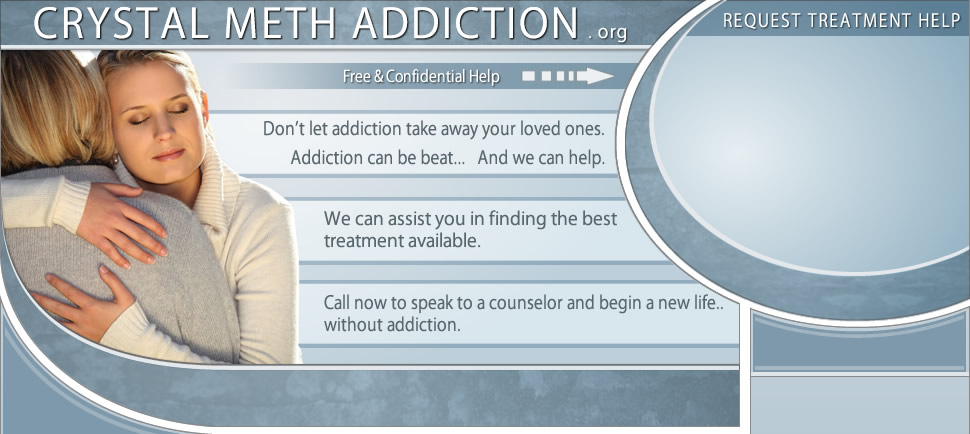Crystal Meth Help
Crystal Meth Effects and Symptoms
- Crystal Meth Effects
- Crystal Meth Withdrawal Symptoms
- Crystal Meth Symptoms
- Crystal Meth Side Effects
- Crystal Meth Overdose
- Injecting Meth
- Ingesting Meth
- Smoking Meth
- Meth and HIV
Crystal Meth Information
- Crystal Meth Addiction Treatment
- Crystal Meth Statistics
- Crystal Meth Facts
- Crystal Meth Prices
- Crystal Meth Street Names
- Crystal Meth Pictures
- Crystal Meth User Pictures
- Teen Meth Addiction
- Meth Addiction
- Drug Rehab for Meth Addiction
- Meth Intervention
Crystal Meth News
Meth Addiction
Meth addiction has currently exploded throughout many areas of the United States over the past several years. A meth addiction problem will sometimes begin with the casual use of the drug; oftentimes the person will be using it for the intense rush that the drug is reported to produce, regardless of the method of ingestion. Other individuals will use meth for what they consider to be more functional purposes, that may include weight loss or to help to give them energy to be able to work longer hours; regardless of the reason that a person starts to use the drug, the casual use of this toxic drug will often escalate into a severe substance abuse problem.
Meth addiction is insidious, and can begin to escalate rapidly. As a meth user begins to ingest this stimulant on a regular basis, they will quickly begin to develop a tolerance to the toxic amphetamine; in short order, they will need to take higher amounts of the drug in order to get that same initial high. This is the reason that the large majority of casual meth users will quickly become dependent on the drug shortly after their first initial use. Regardless of the method of ingestion, whether meth has been injected, swallowed, smoked or sniffed, the smallest amount of this potent stimulant will quickly be absorbed by the body; thus, often propelling the meth user into several days that will be devoid of food or any period of rest.
Meth addiction can quickly begin to take complete hold of the user; thus, when the casual use of the drug develops into a full-blown addiction to the stimulant, it will become painfully obvious that nothing else in the meth user's life holds a significant place. When a meth user becomes physically and psychologically addicted, they will begin striving to achieve the high that they experienced the first time that they used the drug. Unfortunately, this is an impossible endeavor, as the chronic use of meth will gradually begin to suppress the normal production of the feel good chemicals (dopamine) in the brain; in an effort to confirm this, scientists have taken brain scans of a number of former meth users and reported that these brain images indicated that there was a significant decrease (over 20%) in the number of dopamine transporters. This cutting edge research that is related to the long term adverse side effects of meth addiction has concluded that research subjects that were former meth users were also shown to have lost a significant number of brain cells; unfortunately, these neuron losses will often cause a disruption in mental performance, long after a person has stopped using meth.
Because meth addiction wreaks such havoc on an users brain, and because it has the potential to cause irreversible brain damage, it is important for loved ones to intervene immediately upon finding out that a friend or loved one has started using the toxic stimulant; thus, it is vital that these individuals are educated in what types of symptoms are indicative of a meth addiction.
Signs of a Meth Addiction
- One of the most common signs of a meth addiction problem can be when a person exhibits obsessive types of behavior while also becoming fidgety. Because meth is reported to be a stimulant, it can cause an user to begin to exhibit many different types of erratic behaviors, such as cleaning compulsively or repeating the same types of tasks again and again.
- Another hallmark of a meth addiction problem is when a person develops dilated pupils or when their eyes are constantly darting back and forth; additionally, many times a meth user will have eyes that are noticeably red and glazed over.
- An overt sign of a meth addiction problem is when a person begins to ramble, or begins to chatter incessantly.
- A sure sign of a meth addiction is when an individual loses a massive amount of weight in a short amount of time and does not appear have any appetite at all.
- Another trait that is commonly associated with a meth addiction problem is a condition that is commonly referred to as "meth mouth." This condition is often characterized by extreme tooth decay, which includes blackened and missing teeth.
- One of the most obvious signs of a meth addiction problem are skin lesions and sores that begin to appear, that will often appear to take a long time to begin to heal; this is because many of the toxic ingredients that are used to make meth will naturally inhibit the body's natural ability to be able to be able to fight off infections. Another reason for many of these unsightly sores is because meth users, when they are hallucinating, will often try to pick imaginary bugs out from under their skin.
- A common hallmark of a meth addiction problem is when objects that are associated with the use of the drug are found; these items may include charred pieces of aluminum foil, drinking straws that have been cut off, or finding light bulbs that have been transformed into devices that can be used to smoke meth.
Meth addiction can cause a great number of adverse side effects, which can include but are not necessarily limited to, a dramatic increase in blood pressure and heart rate, a significant decrease in the amount of circulation in the extremities, and a significant reduction in the amount of oxygen in the blood stream, which can contribute to the development of skin lesions; additionally, meth addicts will commonly begin to experience episodes of psychosis, in which they have the potential to become extremely violent.
Meth addiction has been reported to be among the most difficult substance abuse problems for drug rehab centers to be able to treat effectively. The physical withdrawal that is associated with meth addiction is not as severe as with many other types of drug that are classified as amphetamines; on the other hand, the emotion withdrawal can be markedly worse. The reason for this is that individuals who have developed a meth addiction will often be unable to experience any type of pleasure in the absence of the drug; unfortunately, this can sometimes last for up to several months, which can lead to chronic episodes of relapse.

